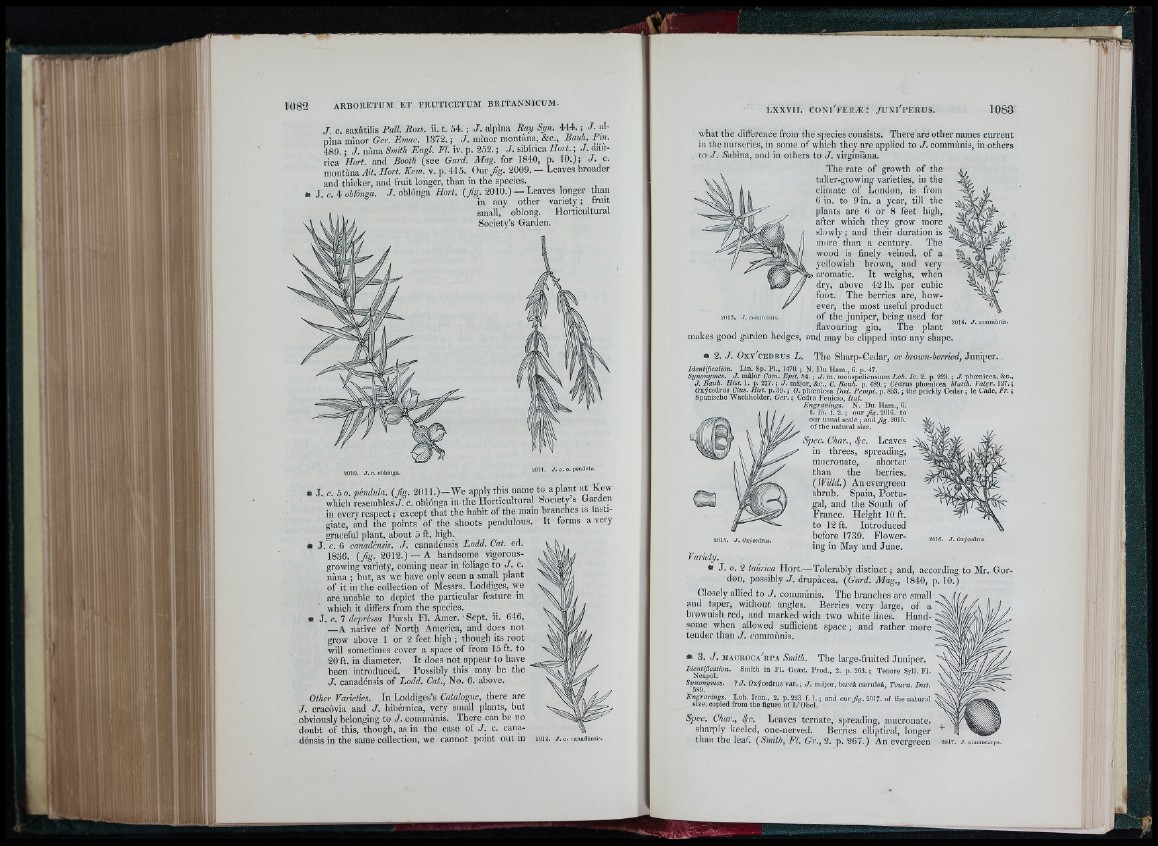
J. c. saxátilis Faü. Ross. ii. t. 54. ; J . alpina Ray Syn. 444. ; . / .a l pina
minor Ger. Emac. 1372. ; J. minor montàna, &c., Bauk. Pm.
489. : J. nàna Smith Engl. FL iv. p. 252. ; J. sibirica Hort. ; J. dau-
rica Hort. and Booth (see Gard. Mag. for 1840, p. 10.); J. c.
montàna Ait. Hort. Kew. v. p. 415. Our flg. 2009. — Leaves broader
and thicker, and frnit longer, than in the species.
• J c. 4 oblónga. J. oblónga Hort. (flg. 2010.) — Leaves longer than
in any other variety ; Iruit
small, oblong. Horticultural
Society’s Garden.
2010. J . c. obltSnga.
2011. J . c. o. péndula.
* J. c. 5 o. péndula. (flg. 2011.)—We apply this name to a plant at Kew
which resembles J .c . oblónga in the Horticultural Society s Garden
in every respect ; except that the habit of the mam branches is lasti-
giate, and the points of the shoots pendulous. I t forms a veiy
graceful plant, about 5 ft, high.
• J. c. 6 canadénsis. J. canadénsis Lodd. Cat. ed.
1836. (Jig. 2012.) — A handsome vigorous-
growing variety, coming near in foliage to J . c.
nana ; but, as we have only seen a small plant
of it in the collection of Messrs. Loddiges, we
are unable to depict the particular feature in
which it differs from the species.
« J. c. 7 depressa Pursh Fl. Amer. 'Sept. ii. 646.
—A native of North America, and does not
grow above 1 or 2 feet high ; though its root
will sometimes cover a space of from 15 ft. to
20 ft. in diameter. It does not appear to have
been introduced. Possibly this may be the
J. canadénsis of Lodd. Cat., No. 6. above.
Other Vaiieties. In Loddiges’s Catalogne, there are
J. cracòvia and hibêrnica, very small plants, but
obviously belonging to J. commiinis. There can be no
doubt of this, though, as in the case of ./. c. canadénsis
in the same collection, we cannot point out in 2012,
what the difference from the species consists. There are o ther names current
in the nurseries, in some of wliich they are applied to J. communis, in others
10 ./. ¿iibina, and in others to J. virginiana.
The rate of growth o f the
taller-growing varieties, in the
climate of London, is from
6 in. to 9 in. a year, till the
plants are 6 or 8 feet high,
after which they grow more
slowly ; and their duration is
more than a century. The
wood is finely veined, of a
yellowish brown, and very
? aromatic. I t weighs, when
dry, above 42 lb. per cubic
foot. The berries are, however,
the most useful product .wivl. . LirilJItl II Ilia. of the iuniper, being used for a y F , 1 o 2,)J4. J . communis. navounng gm. Ih e plant
makes good garden hedges, and may be clipped into any shape.
• 2. .7. O x y 'c e d ru s L. The Sharp-Cedar, or brown-berried. Juniper. .
Identificaiion. Lin. Sp. PJ., 1470.5 N. D u Ham., 6. p. 47.
Synonymes. J. major Cam. Epit. .54. ; J . m. monspeliénsium Lob. Ic. 2. p. 223. ; J. phoenicea, &c,
J. Bauh. Hist. 1. p. 277. ; J. màjor, &c., C. Bauh- p. 489. ; Cèdrus phoenicea Matth. Falgr. 127.
Oxÿcedrus Clus. Hist. p. 39. ; 0. phoenicea Dod. Pempt. p. 853. ; the prickly Cedar ; le Cade, Fr.
Spanische Wachholder, Ger. ; Cedro Fenicio, Ital.
Engravings. N. Du Ham., 6.
t. 15. f. 2. ; our fig . 2016. to
our usual scale ; and/g^. 2015.
of the natural size.
Spec. Char., 4c. Leaves
in threes, .spreading,
mucronate, shorter
than the berries.
( Willd.) An evergreen
shrub. Spain, P o rtu gal,
and the South of
France. Height 10 ft.
to 12 ft. Introduced
before 1739. Flowering
in May and June. 201.5. J . Oxjcedrus. 2016. J . Osycedrus
Variety.
J. 0. 2 taúrica Hort.— Tolerably distinct ; and, according to Mr. Gordon,
possibly J. drupàcea. (Gard. Mag., 1840, p. 10.)
Closely allied to J. commimis. The branches are small
and taper, without angles. Berries very large, of
brownish red, and marked with two white lines. Hand- ;
some when allowed sufficient space ; and rather more
tender than J. commùnis.
« 3. T. macroca'rpa Smith. The large-fruited Juniper.
Identification. Smith in Fl. Græc. Prod.. 2 n
Neapol.
Tenore Syll. Fl.
Synonymes. ? J . OxVcedrus
•. ; J . màjor, baccâ coeruleâ, Tourn. In st.
589.
E n g rm in g s . Lob. Icon., 2. p. 223. f. 1. ; and om f ig . 2017. of th e natural
Size, copied from the figure of L ’Obel.
spec. Char., S;a. Leaves ternate, spreading, mucronate,
sharply keeled, one-nerved. Berries elliptical, longer
than the leaf. (Smith, Ft. Gr., 2. p. 267.) An evergreen